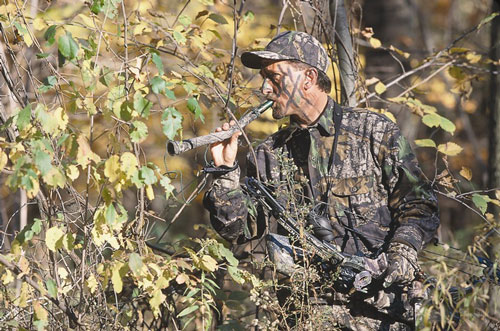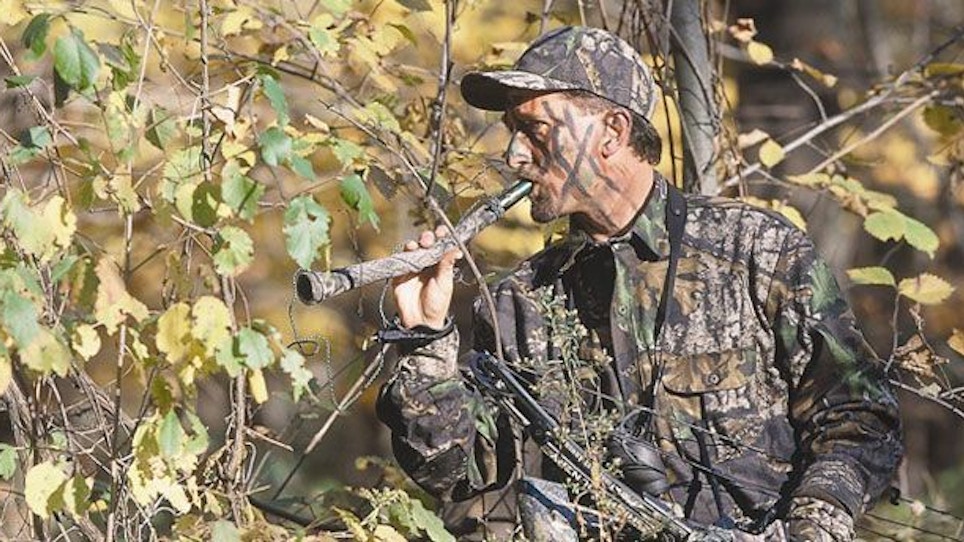 I had him on a string! I first saw the buck working the oak flats below me a half-hour or so after sunup. But by the time I spotted him he had already turned and was slipping out of sight behind a veil of leafless saplings. Instinct told me that in a moment or two he would cross the creek and disappear from my life forever if I didn’t do something, and do it now.
I had him on a string! I first saw the buck working the oak flats below me a half-hour or so after sunup. But by the time I spotted him he had already turned and was slipping out of sight behind a veil of leafless saplings. Instinct told me that in a moment or two he would cross the creek and disappear from my life forever if I didn’t do something, and do it now.
I immediately pulled a variable grunt tube from inside my jacket and imitated a rutting buck by emitting a series of three short “urps” through the reed. Suddenly that buck turned and began walking stiff-legged toward me with his eyes searching the hillside above him for the source of the call.
I hunkered down and watched as the buck continued scanning the woods. After a moment or two, he flicked his tail left to right, and then cautiously took a few more steps forward, intent on pinpointing the whereabouts of the other buck.
That’s when I made a fatal mistake. Instead of waiting to see what would happen next (after all, it was the buck’s next move), I raised the grunt tube back to my mouth and called again. This time the buck swiveled his head a few degrees and looked right at me a mere 40 yards away. Although he couldn’t see me crouched low behind the log, he could see that there wasn’t another deer, buck or doe, on the hillside. Suspicious now, he slowly turned and eased back down the hill. The last time I saw him he was crossing the creek and, as I suspected, out of my life forever.
Three Essential Calling Lessons
That long-ago episode taught me three important lessons about calling whitetails:
1. Grunt tubes can work miracles.
2. Once a buck has responded to your rendition, don’t call again until he turns to walk away.
And,
3. Where you call from is as important as what vocalization you are trying to imitate.
Today I’d be lost without a couple of grunt tubes stuffed into my pockets. In fact, I would rather step afield without my hunting knife than leave my deer calls home. That’s because they give me the edge when dealing with finicky whitetails. Indeed, they can turn an unproductive morning into a memorable one simply by using the right call at the right time and at the right place.
Now, most bowhunters hunt from treestands, and a call here can deliver a passing buck into bow range as well as pull unseen bucks out of the brush and into a pre-set shooting lane. But what many bowhunters don’t realize is that their various deer renditions would work even better if they would call on the prowl. Why? For starters, you see more deer!
Look at it this way. You can glass an agricultural field at primetime and maybe see a dozen deer enter the opening. But if you can move about and glass several fields during that same half- to two-hour primetime period, your odds of seeing dozens of deer are infinitely better.
In addition to seeing more deer, another advantage to calling on the prowl is that you can better imitate a buck from ground zero than you can 10 or 15 feet up a tree. Let’s face it. Bucks don’t hide in the treetops, and if you are calling or rattling from anyplace other than flat on the ground, you can alert a mature buck that something is amiss.
You can also call from more than one position when you set up at ground zero, something you can’t do perched high in a tree. When imitating a rutting buck tending a hot doe, for example, it is best to move slowly along calling every few yards. To call from a stationary position is simply not as natural. When a buck is tending a doe he is generally hot on her heels as she moves about, something that is very difficult to imitate when calling from a treestand.






